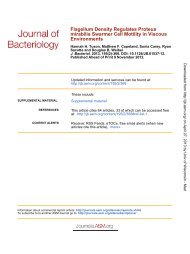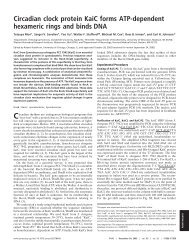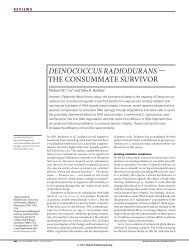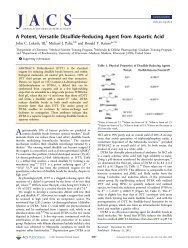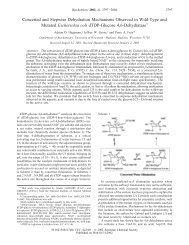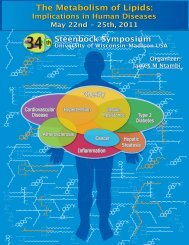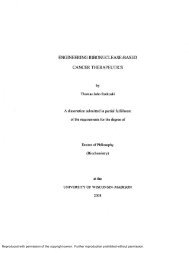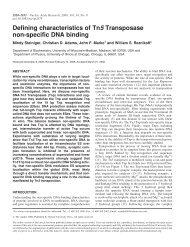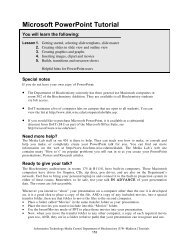The C. elegans Hand gene controls embryogenesis and early ...
The C. elegans Hand gene controls embryogenesis and early ...
The C. elegans Hand gene controls embryogenesis and early ...
Create successful ePaper yourself
Turn your PDF publications into a flip-book with our unique Google optimized e-Paper software.
2890 L. D. Mathies, S. T. Henderson <strong>and</strong> J. Kimble<br />
What happens to SGPs in hnd-1 mutants? We used two<br />
classes of cell death mutants: ced-3, which eliminates all<br />
programmed cell death (Ellis <strong>and</strong> Horvitz, 1986), <strong>and</strong> ced-2,<br />
which is defective in cell corpse engulfment (Ellis et al., 1991).<br />
At first glance, our results appear contradictory: we observed<br />
extra cell corpses in hnd-1; ced-2 double mutants, but saw no<br />
increase in the number of SGPs in hnd-1; ced-3 double<br />
mutants. One simple explanation is that SGPs die by a ced-3independent<br />
pathway. Alternatively, if the SGPs no longer<br />
expressed markers of their fate (e.g. pes-1), they would not<br />
have been identified in our analysis of hnd-1; ced-3 mutants.<br />
<strong>The</strong>refore, it remains possible that hnd-1 mutant SGPs fail to<br />
maintain their fate <strong>and</strong> die via programmed cell death. In either<br />
case, the correlation between missing SGPs <strong>and</strong> extra cell<br />
corpses strongly supports the idea that hnd-1 is required for<br />
SGP survival.<br />
Why might SGPs die in hnd-1 mutants? One simple<br />
explanation is that inhibition of apoptosis is part of the normal<br />
developmental program, as has been suggested for the wingedhelix<br />
transcription factor Fork head in Drosophila salivary<br />
gl<strong>and</strong> development (Myat <strong>and</strong> Andrew, 2000). Alternatively,<br />
cells may be programmed to die when they receive ambiguous<br />
developmental cues. This idea is supported by the extensive<br />
apoptosis seen in many developmental mutants [e.g.<br />
Pax6/eyeless mutants (Halder et al., 1998)]. Because hnd-1<br />
SGPs initially show evidence of their fate (they express SGP<br />
markers <strong>and</strong> migrate to the PGCs), we favor the idea that hnd-<br />
1 is required for maintenance of cell fate <strong>and</strong> that in its absence<br />
the SGPs die. Similarly, Pax6/eyeless mutants <strong>gene</strong>rate eye<br />
primordia that express <strong>early</strong> markers of their fate (e.g. ey-eye<br />
enhancer lacZ) <strong>and</strong> later undergo programmed cell death<br />
(Halder et al., 1998).<br />
hnd-1 <strong>and</strong> embryonic viability<br />
In addition to gonadal defects, hnd-1 mutants can die as<br />
embryos or young larvae with body morpho<strong>gene</strong>sis defects.<br />
Elongation of the embryo is driven largely by cell shape<br />
changes in the hypodermis (Priess <strong>and</strong> Hirsh, 1986). However,<br />
mutants affecting muscle development also disrupt the process<br />
(e.g. Bejsovec <strong>and</strong> Anderson, 1988; Chen et al., 1994;<br />
Waterston, 1989). Of particular interest to this work is the<br />
hlh-1 <strong>gene</strong>, which encodes the C. <strong>elegans</strong> myoD homolog<br />
(Krause et al., 1990); its loss disrupts development of body<br />
wall muscles <strong>and</strong> causes a characteristic morpho<strong>gene</strong>sis defect<br />
(Chen et al., 1994). We explored the possibility that hnd-1 may<br />
similarly be involved in body muscle development. However,<br />
hnd-1; hlh-1 double mutants still make body muscle,<br />
suggesting that these bHLH proteins control different aspects<br />
of muscle development. Although speculative at the current<br />
time, we suggest that hnd-1 may play a role in muscle fate that<br />
parallels its role in controlling SGP fate.<br />
Three <strong>gene</strong>s with overlapping functions in SGP<br />
development<br />
<strong>The</strong> hnd-1 deletion has incompletely penetrant gonadal <strong>and</strong><br />
embryonic defects. Yet, the mouse <strong>and</strong> zebrafish <strong>H<strong>and</strong></strong> mutants<br />
are completely penetrant (Firulli et al., 1998; Riley et al., 1998;<br />
Srivastava et al., 1997; Yelon et al., 2000). Why might a hnd-1null<br />
mutant exhibit partially penetrant defects? One simple<br />
explanation is <strong>gene</strong>tic redundancy. We have identified two<br />
<strong>gene</strong>s, ehn-1 <strong>and</strong> ehn-3, that enhance the hnd-1 phenotype. All<br />
three single mutants have partially penetrant gonadal defects,<br />
<strong>and</strong> mutations in two of the three, hnd-1 <strong>and</strong> ehn-1, also affect<br />
viability. Each of the double mutants has a more severe<br />
gonado<strong>gene</strong>sis defect, which suggests at least two pathways<br />
control SGP survival. Redundancy frequently results from <strong>gene</strong><br />
duplication (Ohno, 1970). However, only one <strong>H<strong>and</strong></strong> homolog<br />
exists in the C. <strong>elegans</strong> genome, <strong>and</strong> neither ehn-1 nor ehn-3<br />
maps to a region containing any predicted bHLH protein.<br />
<strong>The</strong>refore, the hnd-1 <strong>and</strong> EHN <strong>gene</strong>s redundantly control SGP<br />
development, but they are unlikely to represent paralogous<br />
pathways.<br />
Intriguingly, ehn-1 enhances hnd-1 lethality more strongly<br />
than it enhances the hnd-1 gonadal defect, whereas ehn-3<br />
enhances the hnd-1 gonadal defect but not its lethality. <strong>The</strong><br />
identity of hnd-1 as a putative bHLH transcription factor<br />
provides a molecular framework for considering the<br />
enhancement of hnd-1 by ehn-1 <strong>and</strong> ehn-3. One idea is that<br />
ehn-1 <strong>and</strong> ehn-3 might encode, or control the activity of,<br />
transcription factors that cooperate with hnd-1 in the regulation<br />
of partially overlapping sets of target <strong>gene</strong>s. Regardless of the<br />
molecular mechanism, the hnd-1/ehn <strong>gene</strong>s cl<strong>early</strong> have<br />
overlapping, but non-equivalent, functions in embryonic<br />
development <strong>and</strong> gonado<strong>gene</strong>sis.<br />
Regulation of mesoderm development by <strong>H<strong>and</strong></strong><br />
transcription factors<br />
<strong>The</strong> hnd-1 <strong>gene</strong> encodes the single <strong>H<strong>and</strong></strong> transcription factor<br />
in the C. <strong>elegans</strong> genome (Ledent <strong>and</strong> Vervoort, 2001). Higher<br />
vertebrates contain two <strong>H<strong>and</strong></strong> <strong>gene</strong>s (e<strong>H<strong>and</strong></strong>/<strong>H<strong>and</strong></strong>1 <strong>and</strong><br />
d<strong>H<strong>and</strong></strong>/<strong>H<strong>and</strong></strong>2), whereas a single family member has been<br />
identified in zebrafish (Yelon et al., 2000), ascidians (Dehal et<br />
al., 2002) <strong>and</strong> flies (Moore et al., 2000). Vertebrate d<strong>H<strong>and</strong></strong> is<br />
expressed in lateral plate mesoderm <strong>and</strong> is important for<br />
development of mesodermal organs, including heart <strong>and</strong> limbs<br />
(Firulli et al., 1998; Riley et al., 1998; Srivastava et al., 1997;<br />
Yelon et al., 2000). <strong>The</strong> Drosophila <strong>H<strong>and</strong></strong> <strong>gene</strong> is expressed in<br />
the dorsal vessel (heart) <strong>and</strong> visceral mesoderm, but its<br />
function is not known (Moore et al., 2000). <strong>The</strong> C. <strong>elegans</strong><br />
<strong>H<strong>and</strong></strong> <strong>gene</strong>, hnd-1, is first expressed broadly in mesodermal<br />
precursors that <strong>gene</strong>rate striated muscles, <strong>and</strong> then is restricted<br />
to the somatic gonadal precursors; its function appears to affect<br />
both muscle <strong>and</strong> gonadal development. <strong>The</strong>refore, all <strong>H<strong>and</strong></strong><br />
<strong>gene</strong>s explored to date are expressed in mesodermal cells <strong>and</strong>,<br />
where studied, are important for mesoderm development.<br />
<strong>The</strong> defects in hnd-1 have intriguing similarity to the defects<br />
in the zebrafish <strong>H<strong>and</strong></strong> <strong>gene</strong> called h<strong>and</strong>s off (han). Thus, han<br />
mutants <strong>gene</strong>rate the normal number of precardiac cells, but<br />
these cells cannot differentiate <strong>and</strong> a midline heart tube fails to<br />
form (Yelon et al., 2000). Similarly, SGPs are specified<br />
correctly in hnd-1 mutants, but they often fail to maintain their<br />
fate <strong>and</strong> can subsequently die. <strong>The</strong> fate of the cardiac precursors<br />
in zebrafish han mutants is not known (Yelon et al., 2000). We<br />
suggest that the zebrafish <strong>and</strong> nematode <strong>H<strong>and</strong></strong> <strong>gene</strong>s may play<br />
parallel roles in controlling cardiac <strong>and</strong> gonadal precursor cells,<br />
respectively. Interestingly, zebrafish han may also be important<br />
for gonado<strong>gene</strong>sis: han mutants have defects in migration of<br />
germ cells to the gonad as well as abnormalities in pax2.1<br />
expression in the putative gonadal mesoderm (Weidinger et al.,<br />
2002). <strong>The</strong>refore, zebrafish han mutants, like hnd-1 mutants,<br />
might have defects in development of the gonadal mesoderm.<br />
Our identification of hnd-1 as a regulator of somatic gonadal



